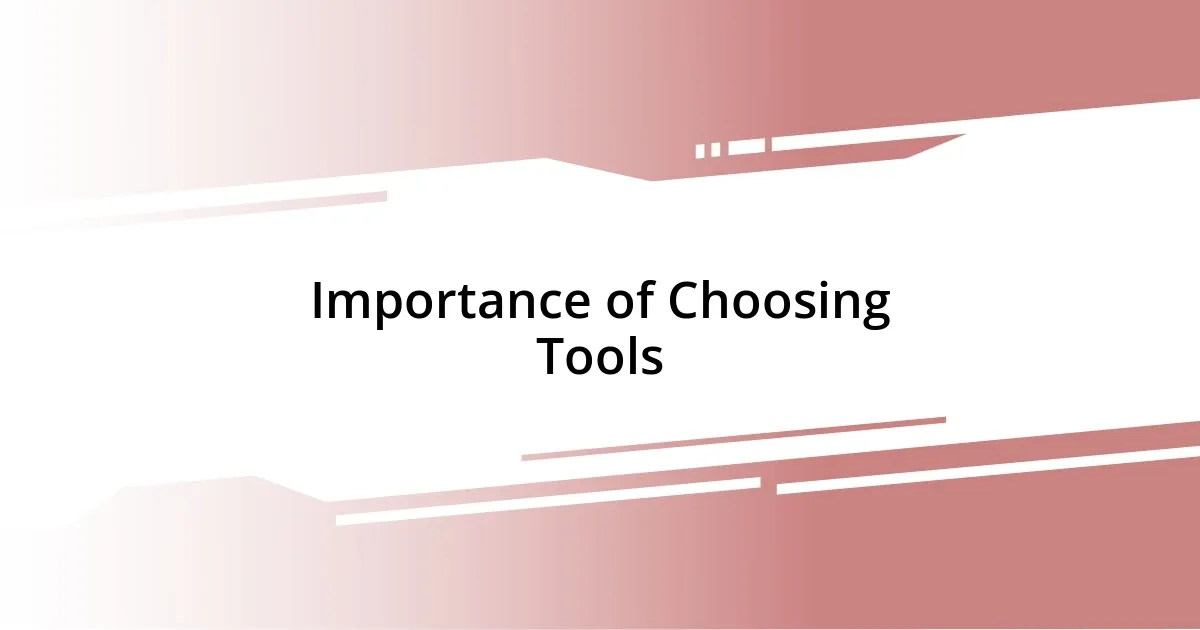Key takeaways:
- The choice of analysis tools significantly impacts the quality of insights and outcomes in data analysis.
- Key features to consider when selecting tools include compatibility, ease of use, functionality, scalability, and support resources.
- Integrating analysis tools into workflows enhances collaboration and can lead to breakthrough results.
- Exploring tool functionalities and seeking feedback can maximize effectiveness and improve future projects.

Overview of Analysis Tools
Analysis tools are essential in navigating complex data landscapes, transforming raw information into insightful narratives. I remember the first time I used a data visualization tool—it felt like unlocking a door to a whole new world. The ability to see patterns and trends that were previously hidden sparked a genuine excitement in me. Have you ever experienced that moment when a tool illuminates your understanding of a problem? It’s truly empowering.
There are various tools available, each tailored to specific needs and contexts. From spreadsheet software like Excel, which I first learned in high school, to advanced statistical packages, the options can be overwhelming. It’s fascinating how the choice of a tool can affect the outcome of your analysis. For instance, I’ve found that using a simple tool for initial analysis often leads to more profound insights when paired with advanced software later on. Have you ever tried switching tools midway through a project? It can be challenging, but sometimes that shift provides the clarity you didn’t know you needed.
Collaboration tools play a crucial role in analysis, especially when multiple perspectives are involved. I once collaborated with a team using a shared analytics platform, and it was eye-opening to see how diverse viewpoints can reshape interpretations. Isn’t it interesting how sharing your analysis with others can reveal blind spots you never considered? Engaging with different analysis tools not only enhances the precision of your work but also enriches the overall analytic process.

Importance of Choosing Tools
Choosing the right tools for analysis isn’t just a matter of convenience; it’s a decision that can significantly influence the quality of your insights. I remember a project where I stubbornly stuck with a tool I was comfortable with, only to find that it limited my ability to explore deeper connections in the data. When I finally decided to experiment with a new tool, I uncovered insights that changed the direction of the entire project. It’s incredible how a slight adjustment in our analytical toolkit can breathe life into our findings.
Here are some important considerations when selecting analysis tools:
- Compatibility: Ensure that the tools work well with your existing systems and data formats.
- Ease of Use: A user-friendly interface can dramatically increase efficiency and reduce frustration.
- Functionality: Look for features that align with the specific needs of your analysis, whether it’s data visualization, statistical modeling, or collaboration.
- Scalability: Choose tools that can grow with your projects, accommodating larger datasets or more complex analyses as needed.
- Support and Resources: Having access to tutorials, community support, or customer service can make a huge difference in your learning curve and effectiveness.

Key Features to Look For
When hunting for the perfect analysis tool, I’ve learned that certain features make a world of difference. One time, I overlooked the importance of user-friendliness and paid the price. I spent hours battling a clunky interface, which drained my enthusiasm. Now, I always recommend testing a tool’s ease of use during the trial phase. It can either invigorate your analysis or lead to unnecessary frustration.
Another key aspect I look for is scalability. As projects evolve, the tool should effortlessly handle increased data complexity. I recall a scenario where I picked a tool that served my needs well at first, but as the datasets grew, it became a bottleneck. Scaling down the line can be a real headache if the chosen tool isn’t up to the challenge. Have you ever felt boxed in by your tools? It’s a feeling I strive to avoid.
Lastly, support and resources are paramount. I’ve often benefited from vibrant online communities or comprehensive tutorials that can turn a struggling moment into a learning opportunity. Once, I encountered a feature I didn’t fully grasp—thanks to a supportive forum, I learned how to harness it effectively. Sharing knowledge enriches the analytic experience, don’t you think?
| Feature | Importance |
|---|---|
| Compatibility | Ensures smooth integration with existing systems. |
| Ease of Use | Enhances efficiency and reduces frustration. |
| Functionality | Aligns with analysis needs like visualization and modeling. |
| Scalability | Accommodates growing datasets and complexity. |
| Support and Resources | Provides guidance and community assistance. |

My Top Analysis Software
One of my favorite analysis software tools is Tableau. I stumbled upon it during a data visualization course, and I was instantly hooked by its intuitive drag-and-drop interface. It felt like painting with data! I remember one project where I transformed a daunting spreadsheet into a visually stunning dashboard, and the reaction from my peers was priceless. Have you ever experienced that ‘aha’ moment when visualizing data suddenly makes complex information clear? It’s moments like these that make me appreciate the right tools.
Another gem in my toolkit is R. Initially, I was intimidated by its coding requirements, but once I dove in, I realized how powerful it is for statistical analysis. I still recall the thrill of running my first regression model and watching the results unfold. It became a trusted companion during a research project where I needed deeper insights. Embracing tools that seem daunting at first can lead to amazing discoveries. Have you ever pushed through that initial discomfort and ended up loving what you learned?
Lastly, I can’t overlook the simplicity and effectiveness of Google Analytics. It’s incredibly useful for tracking user behavior on websites. I remember launching a new site and feeling eager to see how visitors interacted with it. The insights I gained from Google Analytics not only informed my content strategy but also fueled my enthusiasm for ongoing improvements. It’s fascinating how such a straightforward tool can drive impactful decisions. Do you have a go-to tool that shapes your analysis and inspires continuous growth?

Integrating Tools into Workflow
Integrating tools into your workflow is more than just a checkbox. I once faced a project deadline that felt like a runaway train, and I had to quickly integrate a new data analysis tool into my existing processes. The learning curve was steep, but I found that connecting with a colleague who had already used the tool helped make the transition smoother. Have you ever thought how a little teamwork can accelerate your adaptation to new technologies?
I’ve also discovered that maintaining a flexible approach is crucial. Last month, I decided to experiment with a new visualization tool while working on a presentation. At first, I struggled to mesh it with my usual methods, but then I allowed myself to break from my routine. Suddenly, I was creating visualizations that sparked conversations rather than just reporting numbers. Isn’t it amazing how stepping outside of our comfort zones can lead to breakthroughs?
Ultimately, the magic lies in how these tools enhance collaboration. During my last project, I integrated a project management tool that allowed team members to share insights directly from their analysis. It was rewarding to see how inputs from different perspectives enriched our outcomes. When was the last time you saw collaboration transform your project results?

Case Studies of Tool Effectiveness
One standout case study I experienced with Tableau involved a nonprofit organization I volunteered for. They were struggling to present their impact data compellingly to stakeholders. Adopting Tableau, I helped visualize their achievements in real-time. The change was palpable—within weeks, engagement skyrocketed. Have you ever seen a simple visual transformation turn information into a storytelling tool?
In another instance, I used R to analyze survey data for a community initiative aimed at improving local services. The statistical insights I uncovered provided clarity that the team hadn’t anticipated. After presenting the findings, the discussions shifted from frustration about service gaps to actionable strategies based on solid evidence. Isn’t it incredible how digging into raw numbers can illuminate pathways for improvement?
Lastly, Google Analytics played a vital role during a digital marketing campaign I was managing. I meticulously tracked user engagement before and after a specific content piece was published. The spike in traffic and user interactions not only validated our content strategy but also infused the team with newfound confidence. Reflecting on that, I wonder—how often do we overlook the simple data that can spark significant changes in our approach?

Tips for Maximizing Tool Usage
To truly make the most of your tools, I highly recommend taking the time to dive into their features. I recall a day when I felt overwhelmed by the plethora of functionalities in a new analytics platform. I set aside a dedicated hour solely for exploration and experimentation, and that hour transformed my understanding. Have you ever noticed how getting familiar with a tool can unlock hidden potential?
Documentation can be a game changer. I remember sitting in front of my computer, frustrated when a feature didn’t work as I expected. I took a moment to consult the user manual and discovered a better way to approach the task. Rather than simply pushing through lost time, investing in understanding the support materials can save you headaches down the line. Don’t you think it’s worth a few minutes to read through the guides?
Lastly, integrating feedback loops into your tool usage is crucial. After I completed a project with my data modeling software, I invited feedback from team members. Their insights prompted me to reassess my approach and made the next project smoother. Have you ever thought about how a little constructive criticism could elevate your work? Embracing feedback can turn tool usage from a chore into an opportunity for continual improvement.














